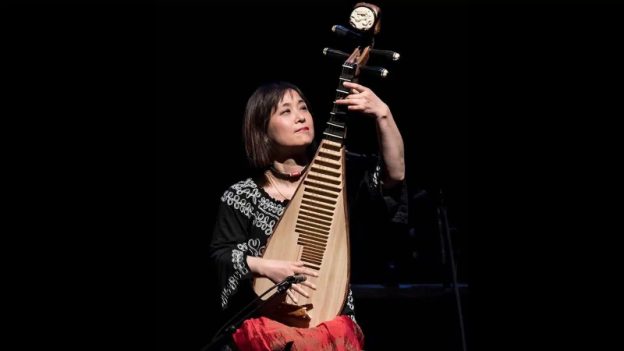September 9, 2025
The Grace Rainey Rogers Auditorium, Metroplitan Museum of Art
New York City, New York – USA
The Knights, Colin Jacobsen, artistic director; Wu Man, pipa.
TRADITIONAL: Chinese pipa repertoire
Lou HARRISON: Concerto for Pipa with String Orchestra
Ben Gambuzza | 12 SEP 2025
On the back of a fragile, 500-year-old Chinese lute held by The Metropolitan Museum of Art in Manhattan, over a hundred ivory plaques displaying Taoist, Confucian, and Buddhist figures and symbols form a golden honeycomb pattern so magnificent and well-preserved that a viewer might wonder whether it is a reproduction.
The pipa—so named for the back (p’i) and forth (p’a) with which the musician plucks the strings—may not be as well known in Western classical music as the Javanese gamelan, the Japanese koto, or the Indian sitar, but it has certainly gained in popularity this century in large part through the efforts of Wu Man.
Tuesday evening, to a full house at the MET’s Grace Rainey Rogers Auditorium, the Hangzhou native gave a rousing East-meets-West performance (on a pipa made a few centuries after the MET’s antique) whose enthusiastic reception demonstrated how hungry Manhattanites are to hear more music from around the world.
Many concerts dedicated to showcasing non-European musical traditions typically pair (with some variation), say, one or two pieces by Western composers who employ non-Western scales and coloring (think Debussy or Rimsky-Korsakov) with perhaps a new piece by a composer of non-European extraction who infuses traditional Western forms with instruments and melodies from their native musical tradition (think Du Yun’s “Ears of the Book,” a pipa concerto that Wu Man premiered here last year).
But Tuesday evening’s program was a departure from this tired formula. The first half of the program was dedicated completely to traditional pipa repertoire, with an added treat of an improvisation by Wu Man. The second half comprised one Western piece: Lou Harrison’s Concerto for Pipa with String Orchestra, which he composed in 1997 for (and with) Wu Man.
Even so, I am an American, Boston-born, so the words that came to mind while listening to Wu Man play Chinese folk music were Italian analogues: “fantasia” and “toccata.” In Xi Yang Xiao Gu (“Flute and Drum Music at Sunset”), which, she explained from the stage, is composed in the “lyrical style,” and others, which included a tea-house tune from her hometown as well as a Kazakh tune she learned from a Kazakh musician, she plucked and strummed with a delicacy and a sense of humor that made some members of the audience let out single sniffly laughs.
It’s unclear whether there is something funny in this music or if this was just an American “isn’t that cute” response to an unfamiliar plucking style. Whatever it was, a distinct throughline seemed to emerge; in each of these pieces, there was dreamlike improvisation tempered by passages of driving intensity, sometimes bordering on the violent. The Toccata from Ravel’s Le tombeau de Couperin might be a worthy comparison. Wu Man let individual notes and chords resonate just long enough, mixing elegance with rustic passion as she let the instrument both sing and rock and roll. Westerners tend to think of Chinese music as all tranquility and flowers. Wu Man’s choice of compositions and her committed artistry convinced me that this stereotype must die.

Lou Harrison (credit: David Harsany)
Lou Harrison (1917-2003) might be forgiven for the exoticizing and Orientalizing of other Western composers if only because he seemed to care so much about understanding Eastern music. Wu Man told the audience from the stage that when Harrison was composing the Pipa Concerto for her, he faxed over a few pages to ask her if it was playable. She was surprised to see, among other idiosyncracies, some flat keys that aren’t convenient to play in on the pipa. He tweaked his work and allowed Wu Man significant interpretive freedom.
Harrison is known primarily for his early ultramodernism (under the influence of his teacher Henry Cowell), his percussion music (partly in collaboration with John Cage), and his reliance on tonality and melody, a practice that few composers of his stature and pedigree dared to revive. He is also known as the one who almost single-handedly introduced American audiences to the gamelan.
Harrison’s usual process in his Eastern-influenced compositions was to pit a Western solo instrument against an ensemble of Asian instruments. In the Pipa Concerto, he reversed this relationship. And while other Western composers (and, in earlier compositions, Harrison himself) relied on the pentatonic scale (a five-tone mode) to give an Eastern flavor to their music, Harrison here employs modes with six tones. The result is a careful, thorough, and fresh fusion of styles.
When Wu Man played the Pipa Concerto with string players from the New York-based ensemble The Knights on Tuesday evening, I thought I heard hip-hop, too, at least in the sultry bass lines. The Knights always sound alive, and tonight was no exception. Their togetherness and verve complemented Wu Man’s enthusiasm as she seemed to invite them into her solo role, making it sound like a big chamber ensemble playing off one another rather than an orchestra providing accompaniment to a star virtuoso.
Introducing the piece, Wu Man mused about exactly what kind of music the pipa concerto is. Is it classical? Is it Chinese? She thinks it’s “very much California,” where Harrison fled after a nervous breakdown in New York. Knights violinist Colin Jacobsen said he sees the music as more “in Esperanto,” the wonky made-up language that Harrison sometimes used to title his pieces. But perhaps the truest answer to the question of classification is what Wu Man gave a journalist back in 1997 when the work had its premiere at UC Berkeley: “It’s Lou Harrison music.”

The Knights (theknightsnyc.com)
It’s a testament to Wu Man’s musical hospitality that the highlight of the entire show was a surprise encore between her and Jacobsen. After Wu Man shouted, “Bring it on!”, the two jammed over a raucous folk tune whose origins are a mystery to me but which both knew.
All music that ever was came from other music that existed before it, near and far. And yet that term “cultural appropriation” always seems to connote a fragility to the tradition being appropriated—as if you use it wrong, it will break or disintegrate. But the reason why artists can employ different musical styles from around the world in their work is that the sonic identities of those styles are so strong. Don’t let the delicacy of the old pipa in the MET’s holdings kid you; pipa music is not always delicate. And when you have as capable a musician as Colin Jacobsen as your jam partner, the bond between Eastern and Western music becomes unbreakable.
As Harrison himself liked to say, “Enjoy hybrid music, because that’s all there is.” ■
EXTERNAL LINKS:
- Wu Man: finland.fi/arts-culture/finlandia-by-jean-sibelius
- The Knights: theknightsnyc.com
- Colin Jacobsen: colinjacobsen.com
- The Metropolitan Museum of Art: metmuseum.org

Read more by Ben Gambuzza.
RECENT POSTS
 Marc-André Hamelin’s ‘Found Objects–Sound Objects’ offers an adventurous survey of contemporary piano music • 12 Dec 2025
Marc-André Hamelin’s ‘Found Objects–Sound Objects’ offers an adventurous survey of contemporary piano music • 12 Dec 2025 Ridibund Chamber Music Society offers mashups, mischief, and midwinter warmth at Eddie’s Attic • 09 Dec 2025
Ridibund Chamber Music Society offers mashups, mischief, and midwinter warmth at Eddie’s Attic • 09 Dec 2025




.png)